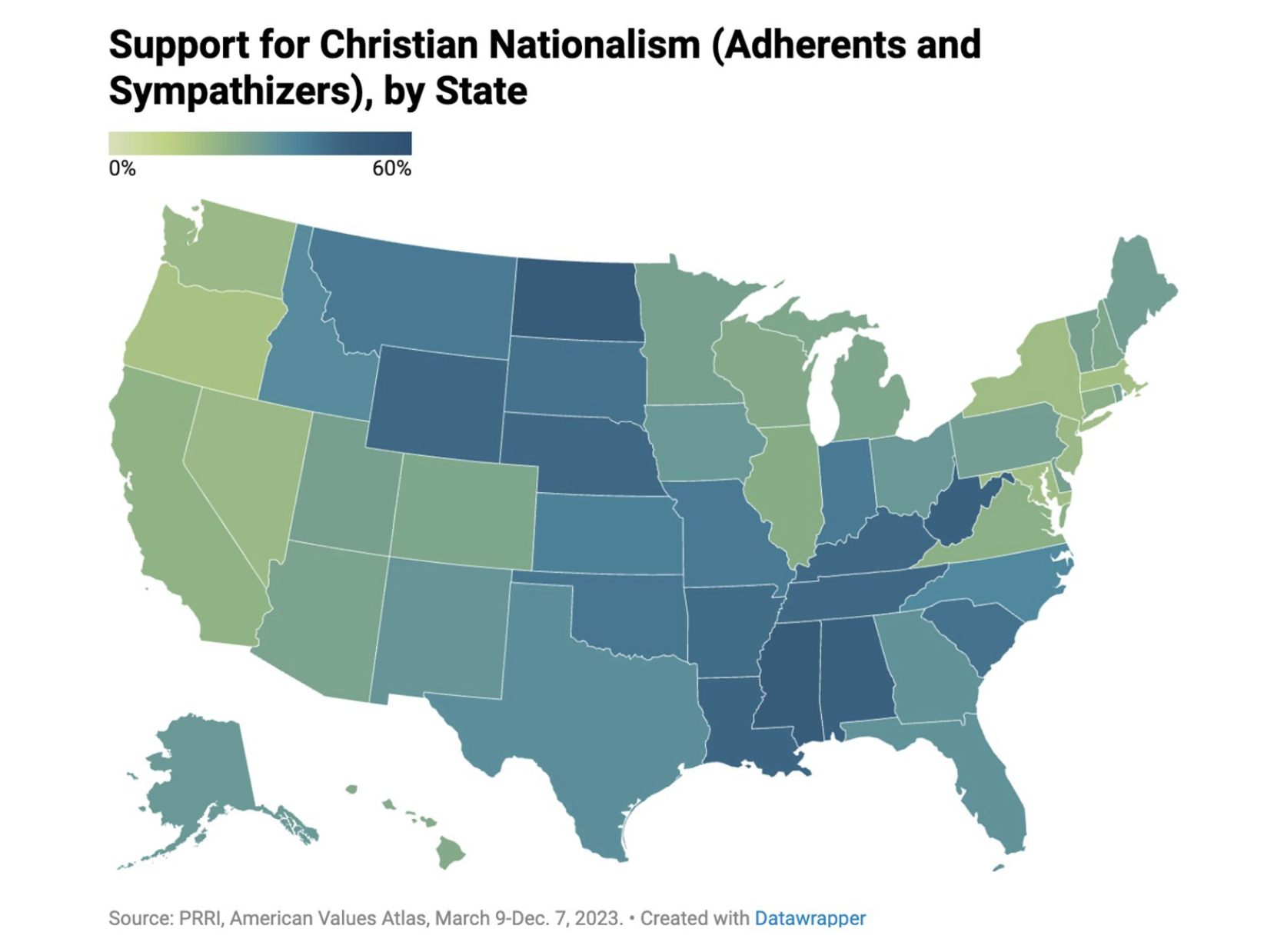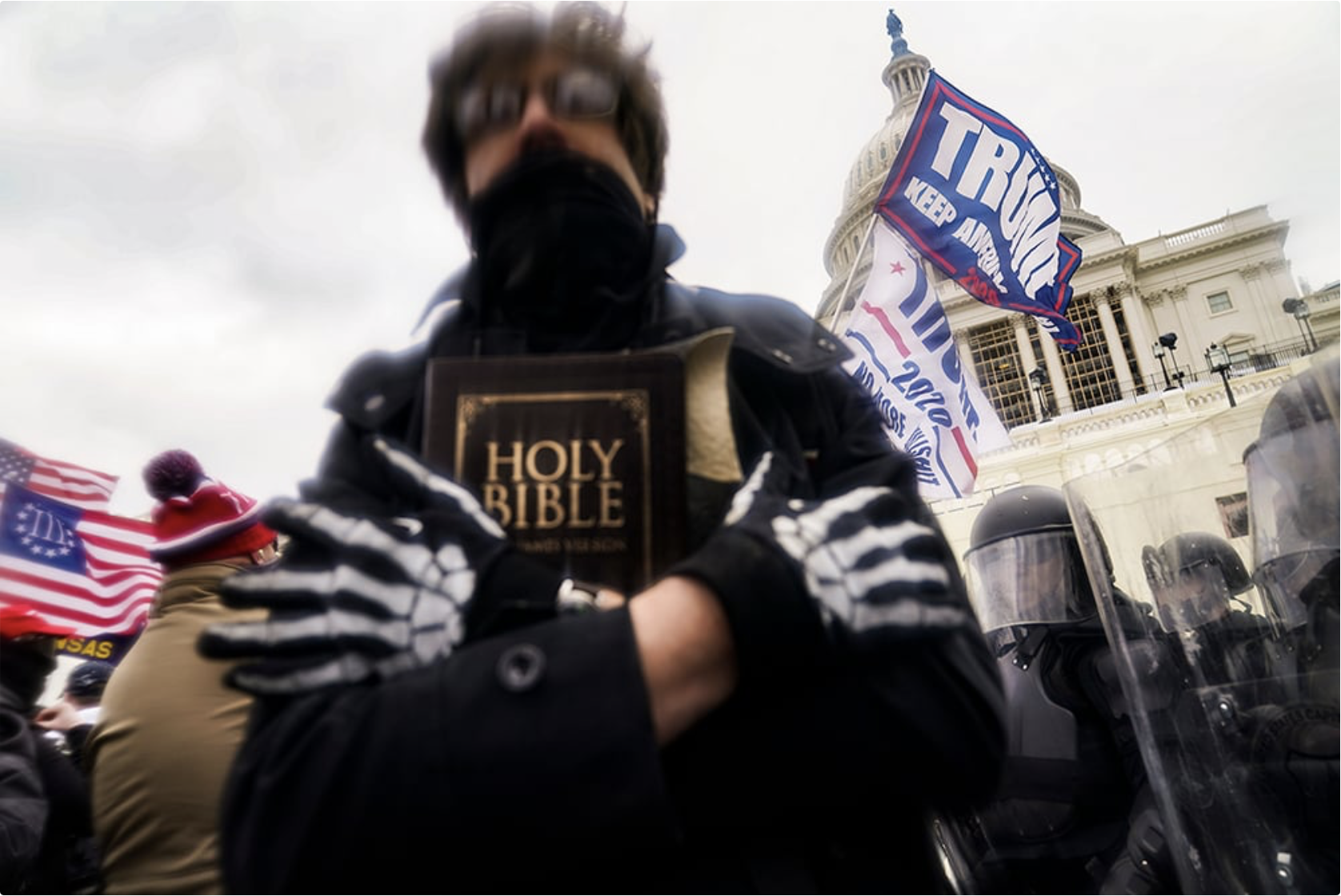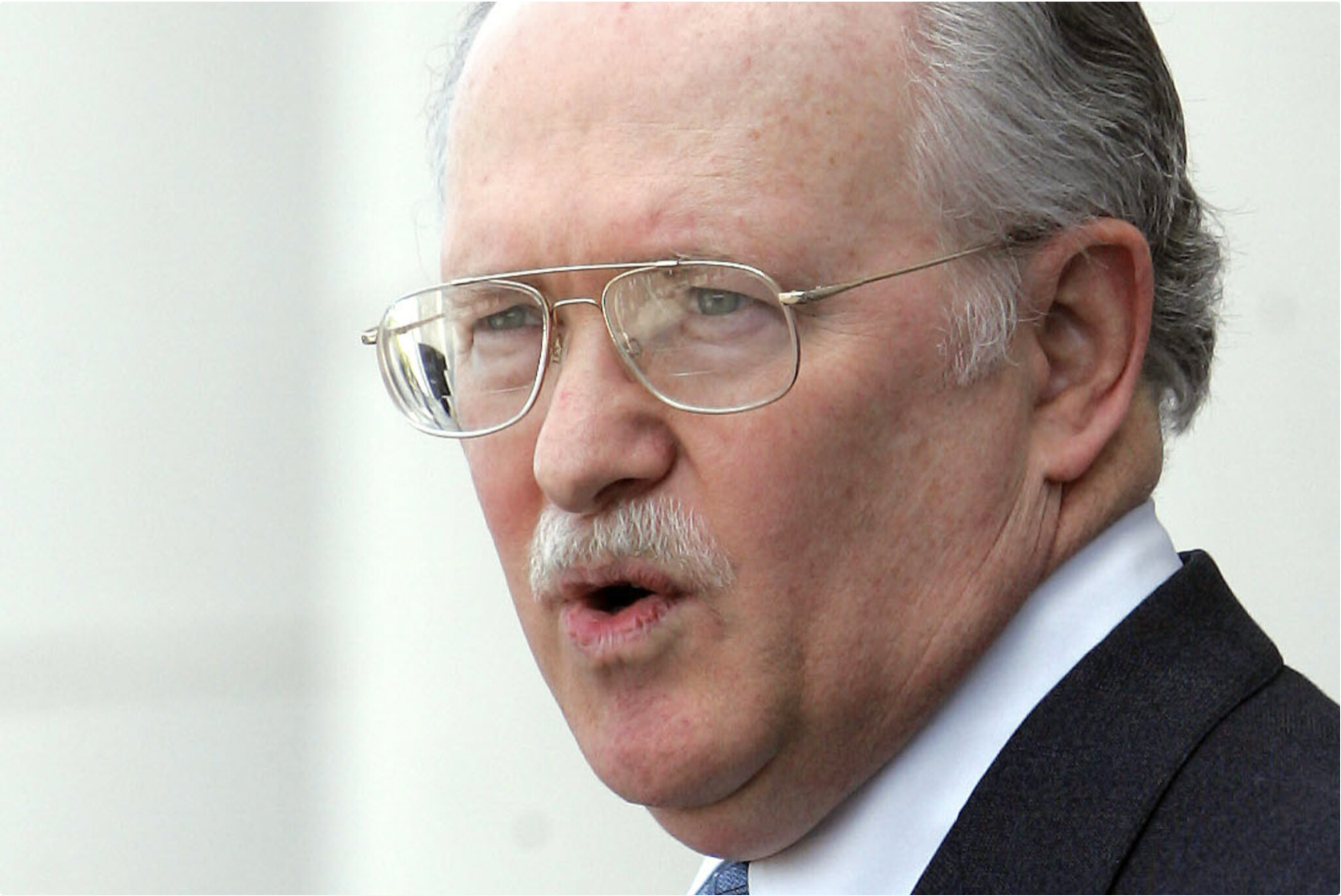BRENTWOOD, Tennessee – Los pastores de las iglesias protestantes hispanas de Estados Unidos tienen una inmensa gratitud por el papel que desempeñan, pero muchos se enfrentan a dificultades económicas.
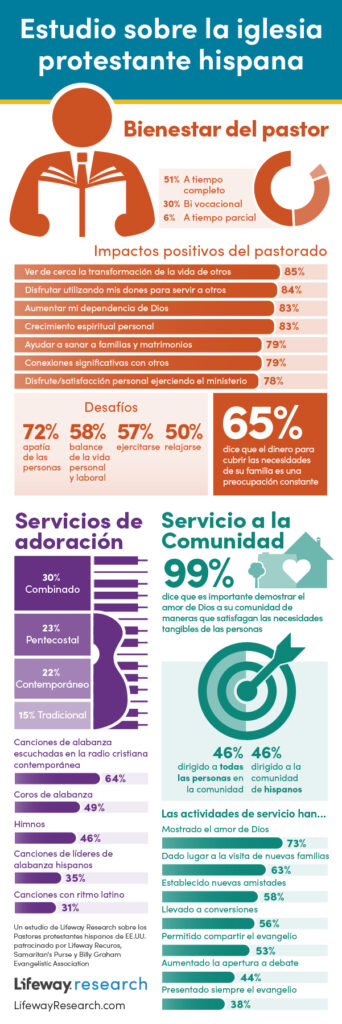 Sus congregaciones reflejan estilos de servicio de adoración diversos, pero tienen un deseo unificado por alcanzar y servir a sus comunidades.
Sus congregaciones reflejan estilos de servicio de adoración diversos, pero tienen un deseo unificado por alcanzar y servir a sus comunidades.
Lifeway Research se asoció con numerosas denominaciones y redes de iglesias para encuestar a pastores protestantes hispanos de Estados Unidos en un estudio patrocinado por Lifeway Recursos, Billy Graham Evangelistic Association y Samaritan’s Purse.
Este estudio es la continuación de un estudio de Lifeway Research sobre pastores protestantes hispanos de EE.UU. del año pasado, centrado en las congregaciones y su alcance evangelístico.
“La respuesta de pastores y líderes sobre el primer estudio que hicimos el año pasado fue abrumadora”, dijo Giancarlo Montemayor, director de publicaciones globales para Lifeway Recursos.
“El objetivo con este segundo estudio es profundizar en algunos de los matices de la iglesia hispana en EE.UU., como la adoración y el alcance. También queríamos prestar mucha atención a las necesidades particulares de los pastores que sirven en estas comunidades, que a menudo luchan con cuestiones culturales y políticas que no están presentes en una iglesia de habla inglesa”.
Perspectivas pastorales
El pastor protestante hispano promedio comparte muchas similitudes con otros pastores protestantes, aunque también tiene algunas características únicas. Los pastores participantes son en su inmensa mayoría evangélicos, con un 82 % que se identifica como tal, frente a un 17 % que se declara protestante de línea principal.
Siete de cada 10 tienen algún tipo de educación superior, incluido un 44 % que tiene un título de posgrado. En cuanto a su formación teológica, casi la mitad ha realizado cursos de formación en institutos bíblicos (47 %) o en seminarios (46 %).
Más de un tercio tiene un máster de un seminario (38 %) o ha tomado cursos de un instituto bíblico (34 %). Una cuarta parte (25 %) ha realizado cursos de la escuela de la iglesia, mientras que el 12 % tiene un doctorado de seminario. Pocos (3 %) dicen no tener formación teológica formal.
La mitad de los pastores protestantes hispanos de EE.UU. (51 %) dicen que trabajan a tiempo completo en su iglesia. Tres de cada 10 (30 %) sirven bivocacionalmente, el 13 % son voluntarios, el 6 % trabajan a tiempo parcial y el 1 % son interinos.
De los que son bivocacionales, el 88 % trabaja 20 horas o más en su trabajo externo, incluido el 51 % que trabaja al menos 40 horas fuera de la iglesia. Los pastores bivocacionales dicen que lo hacen principalmente porque es una necesidad económica para sus familias (79 %).
La mitad (48 %) dice que tiene un segundo trabajo porque ayuda económicamente a la iglesia. Tres de cada 10 (30 %) trabajan externamente porque su familia necesita las prestaciones del seguro.
Menos de una cuarta parte dicen que lo hacen para identificarse mejor con la población a la que quieren llegar (23 %) o porque se sienten llamados a ser bivocacionales (21 %). Casi 1 de cada 5 (18 %) dice que tiene un trabajo fuera de su iglesia porque disfruta trabajar.
La mitad (52 %) de los pastores protestantes hispanos dicen que su cónyuge también trabaja para ayudar económicamente a la familia, incluido el 29 % que dice que los ingresos adicionales son esenciales y el 23 % que dice que facilitan las cosas económicamente a su familia.
Pocos (6 %) dicen que su cónyuge trabaja pero que los ingresos no son esenciales. Casi 2 de cada 5 (38 %) dicen que su cónyuge no tiene un trabajo remunerado necesario para ayudar a mantener los gastos de su familia.
“Las fuentes de formación de los pastores de las iglesias hispanas son más diversas que los seminarios por sí solos”, dijo Scott McConnell, director ejecutivo de Lifeway Research. “Del mismo modo que algunos no pudieron ser estudiantes a tiempo completo para prepararse para el pastorado, muchos deben mantener un empleo además de su función de pastor para proveer económicamente para sus familias”. 
A los pastores protestantes hispanos de EE.UU. también se les hicieron preguntas similares a las del reciente estudio de Lifeway Research sobre las Mayores necesidades de los pastores, para determinar sus problemas más acuciantes. Sin embargo, estas preguntas y opciones surgieron de entrevistar específicamente a pastores protestantes hispanos.
Se preguntó a los pastores por los retos de su vida familiar, su bienestar emocional y físico, la dinámica de la congregación y sus necesidades personales.
La mayoría identificó tres problemas concretos que, según ellos, requerían atención: la apatía o la falta de compromiso de las personas de su congregación (72 %), el balance entre el trabajo y el hogar (58 %), la práctica constante de ejercicio físico (57 %) y dedicar tiempo a relajarse y divertirse fuera del trabajo (50 %).
Cuando afrontan problemas, los pastores protestantes hispanos de EE.UU. son los más propensos a recurrir regularmente a su cónyuge. La mitad (51 %) dice que comparte abiertamente sus luchas con su cónyuge al menos una vez al mes.
Más de un tercio (37 %) recurre a otro pastor. Alrededor de una cuarta parte habla con un amigo íntimo (26 %) o un mentor (24 %).
Menos lo comparten mensualmente con otro líder de la iglesia (13 %), un consejero (7 %) o un grupo de estudio bíblico de la iglesia (6 %). Casi 1 de cada 5 (18 %) dice que no comparte abiertamente sus luchas con ninguna de estas personas en su vida.
Independientemente de los retos, los pastores protestantes hispanos de EE.UU. creen que dirigir una iglesia les ha beneficiado de varias maneras.
Más de 4 de cada 5 dicen que han recibido un impacto positivo como pastores al ver de cerca la transformación de la vida de otras personas (85 %), experimentar un disfrute personal al utilizar sus dones para servir a otros (84 %), aumentar su dependencia de Dios (83 %) y ver un crecimiento espiritual personal (83 %).
Un poco menos dijeron que habían visto un impacto personal positivo ayudando a sanar a familias y matrimonios (79 %), estableciendo conexiones significativas con otros (79 %) y experimentando disfrute o satisfacción personal ejerciendo su ministerio (78 %).
Menos del 1 % dice que no ha tenido ninguna de estas experiencias, mientras que el 62 % de los pastores dice que ha experimentado las siete.
“Aunque muchos se han dado cuenta de las dificultades muy reales a las que se enfrentan los pastores en EE.UU., los pastores de las iglesias hispanas se apresuran a centrarse en los aspectos positivos”, dijo McConnell.
“Muchos de los miembros de las iglesias hispanas trabajan largas horas y sus pastores suelen hacer lo mismo. En medio de estos retos, los pastores han crecido espiritualmente y disfrutan sirviendo a otros”.
Servicio de adoración
En cuanto a los tipos de servicios de adoración que dirigen los pastores protestantes hispanos de EE.UU., destaca la variedad potencial.
Lo más probable es que digan que su estilo de adoración se describiría como una combinación de tradicional/contemporáneo (30 %), pentecostal (23 %), contemporáneo (22 %) o tradicional (15 %).
Pocos ven sus servicios de adoración como litúrgicos (3 %), postmodernos/emergentes (2 %) o contemporáneos urbanos (2 %).
Durante esos servicios, lo más probable es que los asistentes oigan canciones de alabanza escuchadas en la radio cristiana contemporánea (64 %).
Casi la mitad de los pastores dicen que su iglesia utiliza coros de alabanza (49 %) o himnos (46 %), mientras que alrededor de un tercio presenta canciones escritas por líderes de alabanza hispanos (35 %) o canciones con ritmo latino (31 %).
Como parte del servicio de adoración, es más probable que las iglesias utilicen palabras proyectadas en la pantalla (90 %) que himnarios (18 %). Alrededor de la mitad presentan notas del sermón en la pantalla (53 %) o muestran un vídeo (49 %).
Los instrumentos más utilizados son la guitarra (78 %), el piano o el teclado (77 %) y la batería (71 %). Pocos utilizan un órgano (8 %), mientras que la mitad dice utilizar algún otro instrumento (51 %).
“Los servicios de adoración en la iglesia hispana dentro de EE.UU. suponen un reto considerable porque tratas con primeras, segundas y terceras generaciones de inmigrantes que entre sí tienen necesidades específicas”, dijo Montemayor.
“Un creyente inmigrante de primera generación probablemente necesitará un servicio completamente en español, mientras que la segunda y tercera generación pueden haber perdido algunas de las características culturales y lingüísticas de sus padres, prefiriendo un sermón en inglés pero canciones en español”.
Los servicios de las iglesias protestantes hispanas de EE.UU. presentan muchos de los mismos elementos que otras iglesias protestantes y a menudo los repiten cada semana.
Casi todas las iglesias tienen un sermón (99 %), lectura de las Escrituras (96 %) y cantos congregacionales (95 %) cada semana.
Alrededor de 9 de cada 10 dicen que su servicio semanal incluye la oración pastoral (93 %), el saludo de los asistentes (91 %) y la oración de intercesión por los enfermos y necesitados (87 %).
Alrededor de 7 de cada 10 también incluyen cada semana una invitación a responder o llamado al altar (72 %), lectura congregacional (70 %) e historias para niños (69 %).
Otros elementos son más esporádicos o dependen de la congregación concreta. Casi 2 de cada 5 (38 %) dicen que la congregación recita una oración cada semana, pero el 45 % dice que eso nunca ocurre en su iglesia.
En el 38 % de las iglesias protestantes hispanas de EE.UU. dedica un tiempo a los testimonios semanalmente, en el 25 % mensualmente, en el 13 % trimestralmente, en el 16 % menos de una vez al trimestre y en el 9 % nunca.
En un puñado de congregaciones, la recitación de credos ocurre semanalmente (15 %), mensualmente (4 %), trimestralmente (5 %) o con menos frecuencia (10 %), pero 2 de cada 3 pastores (66 %) dicen que nunca ocurre en su iglesia.
Casi todas las iglesias protestantes hispanas de Estados Unidos incluyen regularmente la participación en la Cena del Señor (99 %) y el bautismo (97 %), pero sus ritmos para hacerlo varían.
El momento más popular para la Cena del Señor es mensual (58 %), seguido de trimestral (22 %), semanal (12 %) y menos de una vez al trimestre (7 %).
Los bautizos son menos frecuentes, ya que casi la mitad afirma que se celebran en su iglesia menos de una vez al trimestre (47 %) y un número ligeramente inferior afirma que el momento suele ser trimestral (39 %). Son menos los que dicen que tienen bautizos mensuales (7 %) o semanales (4 %).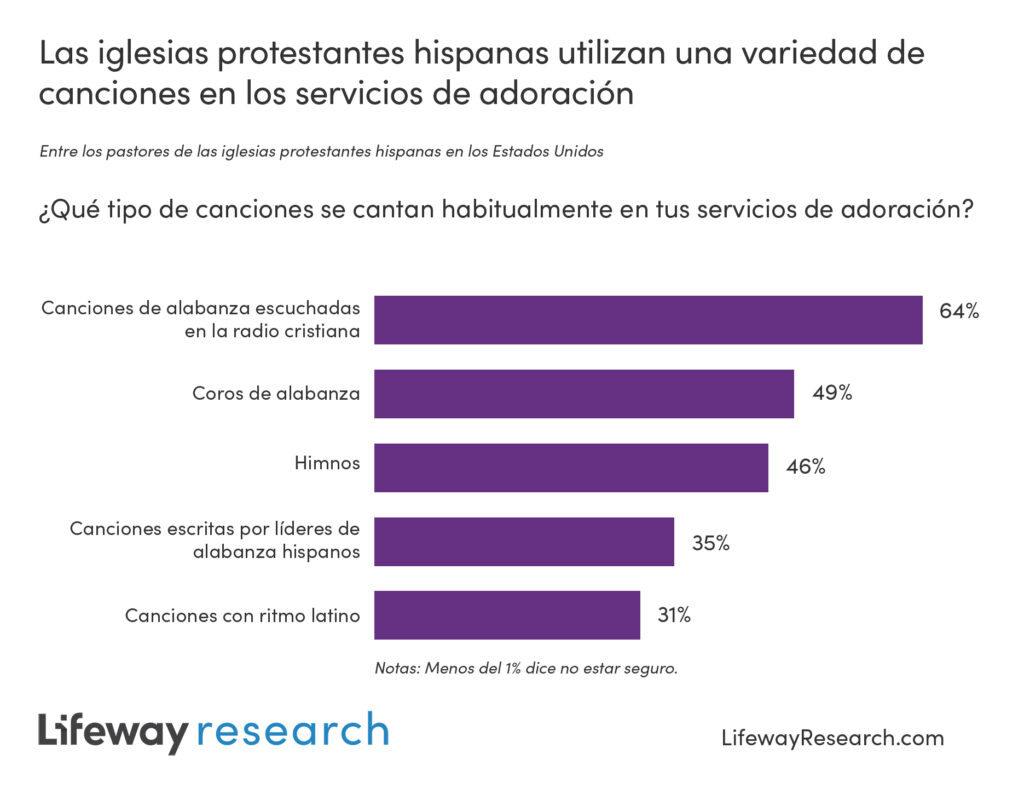
Servicio a la comunidad
A las iglesias protestantes hispanas de EE.UU. no sólo les preocupa lo que ocurre dentro de sus edificios. Servir a su comunidad es una prioridad. Casi todos los pastores (99 %), incluido el 88 % que está totalmente de acuerdo, afirman que es importante que su iglesia muestre el amor de Dios a su comunidad de manera que satisfaga las necesidades tangibles de las personas.
Los pastores están divididos en cuanto a quién buscan ministrar con sus proyectos de servicio o ministerios de servicio en curso: El 46 % dice que a todas las personas de su comunidad, y el 46 % dice que a todas las personas hispanas de su comunidad. Pocos (6 %) dicen que se centran específicamente en los nuevos inmigrantes hispanos.
“La iglesia hispana en EE.UU. se caracteriza por satisfacer necesidades tangibles de los miembros de su comunidad mediante el servicio”, dijo McConnell.
“Algunas iglesias hispanas tratan de satisfacer las necesidades de todos los que las rodean, mientras que otras se centran en servir a los hispanos por razón de idioma o afinidad”.
Cuando se les preguntó específicamente cómo sirvieron a la comunidad el año pasado, el 92 % dijo que sí hacían algo. La mayoría dijo que ofrecía consejería matrimonial (60 %) y daba de comer a los necesitados (53 %).
Muchos proporcionaron ropa a los pobres (44 %), dieron material para el regreso a clases de los niños (43 %), ayudaron a la gente a encontrar empleo (39 %), ayudaron a los ancianos (31 %) y ayudaron a personas a encontrar vivienda (29 %).
Menos dijeron que su iglesia apoyaba a las escuelas locales (21 %), proporcionaba ayuda a las madres de recién nacidos (17 %), ayudaba a las víctimas de catástrofes (17 %), se reunía con personas en prisión (13 %) o proporcionaba ministerios o grupos de rehabilitación o adicción (11 %).
Pocas iglesias acogieron a personas sin hogar (9 %), dieron clases particulares a escolares (8 %), ofrecieron programas extra curriculares (6 %) o se ofrecieron como voluntarias para proporcionar acogimiento familiar (3 %).
En cuanto a la atención a los inmigrantes, el 89 % de los pastores protestantes hispanos de EE.UU. afirmaron que su iglesia está preparada para atender a los nuevos inmigrantes de su comunidad.
En términos concretos, el 75 % identificó una forma de servir a los inmigrantes en el último año. Más de la mitad (54 %) dijeron que satisfacían necesidades de información. Alrededor de 2 de cada 5 los trasladaron o transportaron (41 %) y les ayudaron con cuestiones jurídicas y de inmigración (37 %).
Una cuarta parte (24 %) dijeron que enseñaban administración de dinero, mientras que el 18 % ofrecían clases de inglés como segunda lengua o mentoría y el 9 % enseñaban habilidades laborales.
Aunque el 70 % de los pastores están de acuerdo en que siempre tienen los recursos que necesitan para apoyar los ministerios que consideran esenciales, también indican que probablemente podrían hacer más si tuvieran más.
La mayoría afirma que entre los retos importantes para servir a su comunidad se encuentran la necesidad de entrenar a más personas (56 %), la falta de recursos económicos (52 %) y la falta de suficientes trabajadores para salir a servir (51 %).
Poco menos de la mitad señalan la falta de recursos para ofrecer ayuda jurídica en materia de inmigración (49 %), no contar con líderes que asuman la responsabilidad (47 %) y la dificultad para dedicar el tiempo necesario (44 %).
Menos dicen que no disponen de instalaciones (31 %), que muchas personas de la iglesia se encuentran entre las que necesitan ayuda (30 %) y que carecen de conocimientos sobre oportunidades de empleo y vivienda (23 %).
Nueve de cada 10 pastores protestantes hispanos de EE.UU. (86 %) dicen que los esfuerzos de enseñanza, evangelización y discipulado de su iglesia se han visto impactados por su servicio comunitario.
Alrededor de 3 de cada 4 dicen que su iglesia ha podido mostrar el amor de Dios a su comunidad (73 %). La mayoría afirma que su servicio ha dado lugar a la visita de nuevas familias a su iglesia (63 %), al establecimiento de nuevas amistades con personas de la comunidad (58 %) y que personas acepten a Cristo como Salvador (56 %).
Muchos (44 %) dicen que el servicio de la iglesia en la comunidad ha aumentado la apertura de la gente a debatir y escuchar lo que la iglesia tiene que decir. La mayoría de los pastores (53 %) dicen que su trabajo en la comunidad les ha dado oportunidades de compartir el mensaje del evangelio ocasionalmente, mientras que el 38 % dice que sus proyectos de servicio siempre incluían una presentación del evangelio.
“Mi oración es que la iglesia mundial pueda utilizar este estudio para informar mejor sus decisiones sobre cómo llegar a la comunidad hispana y ayudar a las iglesias que ya están haciendo el trabajo pesado”, dijo Montemayor.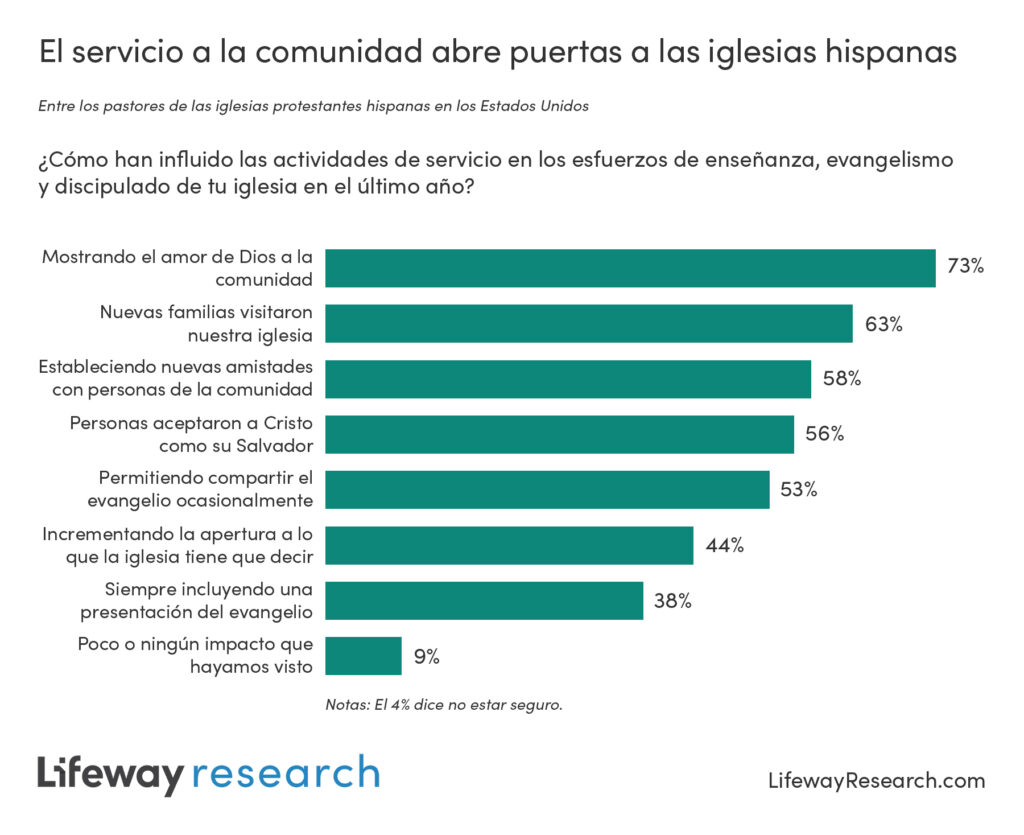
La encuesta en línea a 554 pastores de congregaciones hispanas de EE.UU. se realizó del 12 de septiembre al 1 de noviembre de 2023. Fue patrocinada por Billy Graham Evangelistic Association, Samaritan’s Purse y Lifeway Recursos.
Los encuestados fueron invitados por distintas confesiones y redes, entre ellas Assemblies of God [Asambleas de Dios], Baptist Missionary Association of America [Asociación Misionera Bautista de América], Christian Church (Disciples of Christ) [Iglesia Cristiana (Discípulos de Cristo)], Christian Reformed Church North America [Iglesia Cristiana Reformada de Norteamérica], Church of God (Cleveland) [Iglesia de Dios (Cleveland], Church of the Nazarene [Iglesia del Nazareno], Christian & Missionary Alliance [Alianza Cristiana y Misionera], Converge [Convergencia], Episcopal Church [Iglesia Episcopal], Evangelical Free Church of America [Iglesia Evangélica Libre de América], Foursquare, Free Methodists [Metodistas Libres], New Thing [Algo nuevo], North American Baptists Conference (Hispanics for Christ) [Conferencia de Bautistas Norteamericanos (Hispanos para Cristo)], Presbyterian Church in America (MNA) [Iglesia Presbiteriana de América (MNA)], Reformed Church in America [Iglesia Reformada de América], Southern Baptist Convention [Convención Bautista del Sur], United Pentecostal Church International [Iglesia Pentecostal Unida Internacional], Vineyard and Wisconsin Evangelical Lutheran Synod [Sínodo Evangélico Luterano de Wisconsin y Vineyard], así como iglesias vinculadas a Billy Graham Evangelistic Association [Asociación Evangelística Billy Graham], National Hispanic Christian Leadership Coalition (NHCLC) [Coalición Nacional de Liderazgo Cristiano Hispano (NHCLC)] y National Latino Evangelical Coalition (NaLEC) [Coalición Nacional Evangélica Latina (NaLEC)].
Las invitaciones se hicieron principalmente por correo electrónico, proporcionando a los pastores un enlace a la encuesta en línea. Se examinó a cada encuestado para asegurarse de que era el pastor principal o el pastor del campus hispano o de la congregación de habla hispana.
Se seleccionó a los encuestados para asegurarse de que la congregación era una iglesia hispana o multiétnica o un servicio o campus de habla hispana dentro de una iglesia no hispana (se indicó a los pastores de un campus o servicio de habla hispana que sólo respondieran por ese campus/servicio). Sólo se incluyeron las congregaciones con al menos un 50% de hispanos.
Se utilizaron ligeras ponderaciones para ajustar los distintos índices de respuesta entre denominaciones. La muestra completa es de 554 encuestas. La muestra proporciona un 95 % de confianza en que el error de muestreo no supera más o menos el 5,2 %. Este margen de error tiene en cuenta el efecto de la ponderación. Los márgenes de error son mayores en los subgrupos.


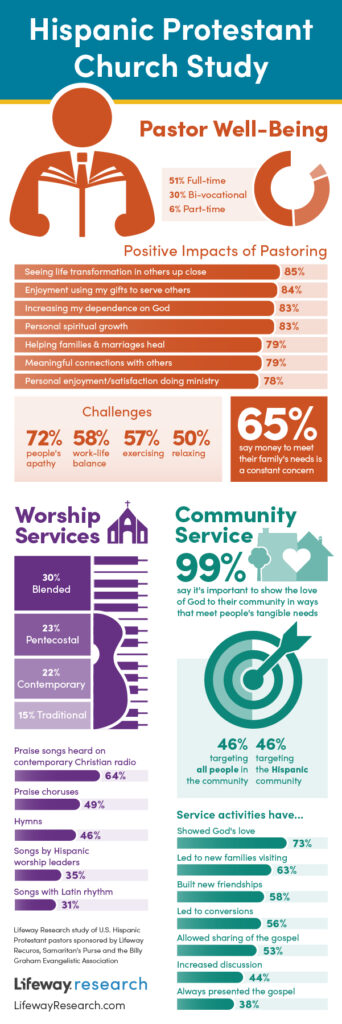 Their congregations reflect diverse worship styles, but they have a unified desire to reach and serve their communities.
Their congregations reflect diverse worship styles, but they have a unified desire to reach and serve their communities.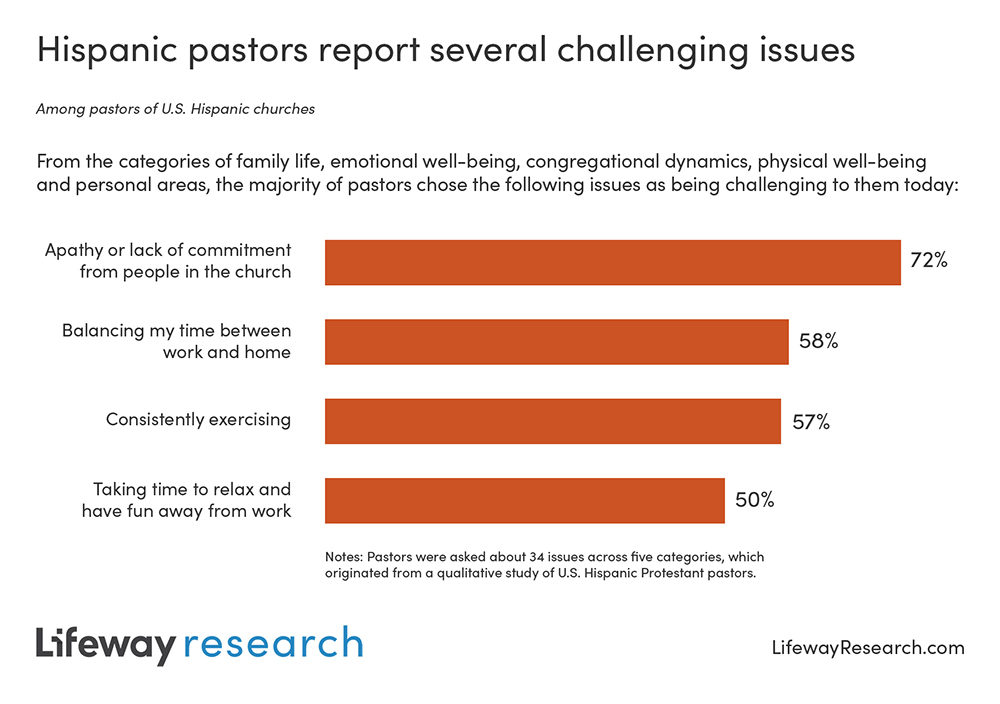
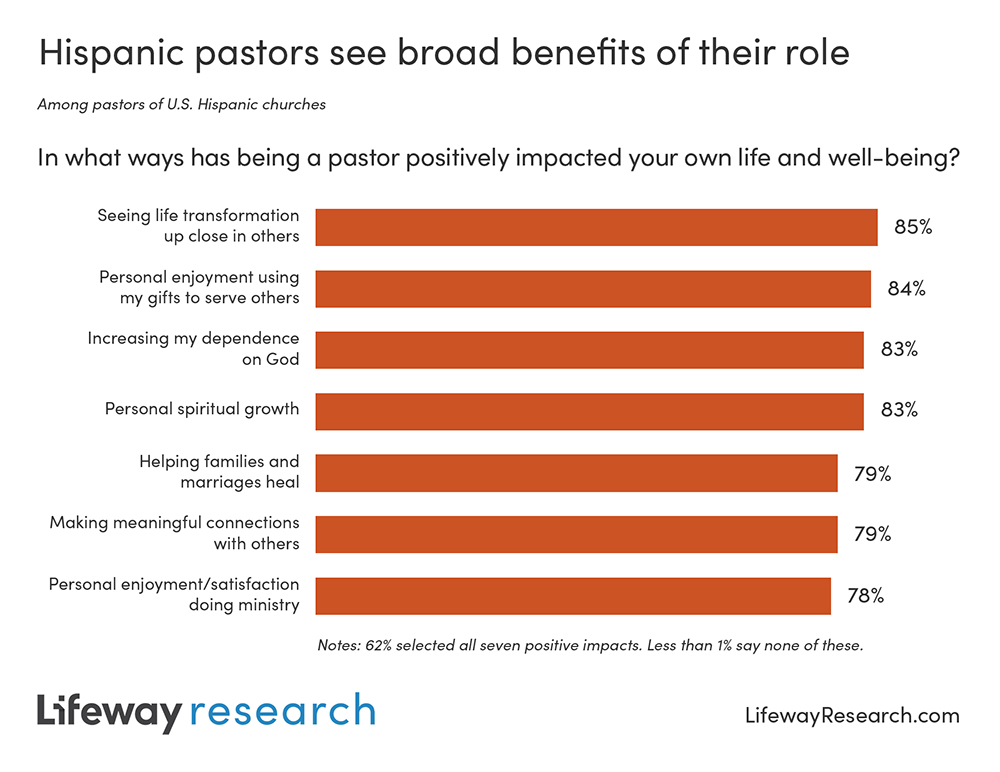
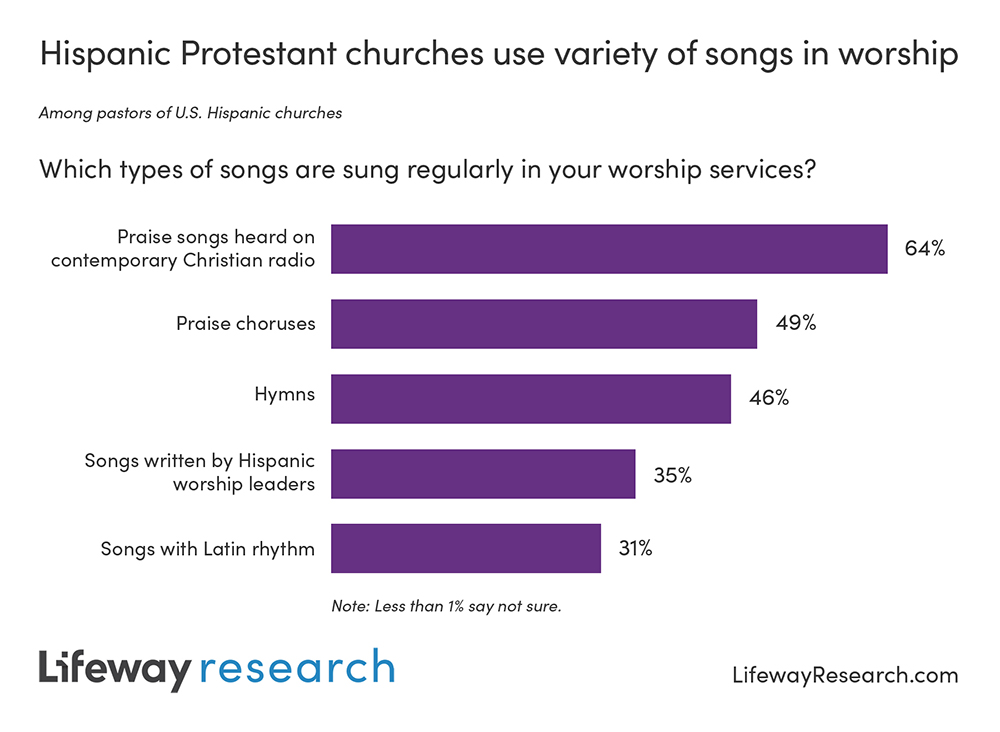
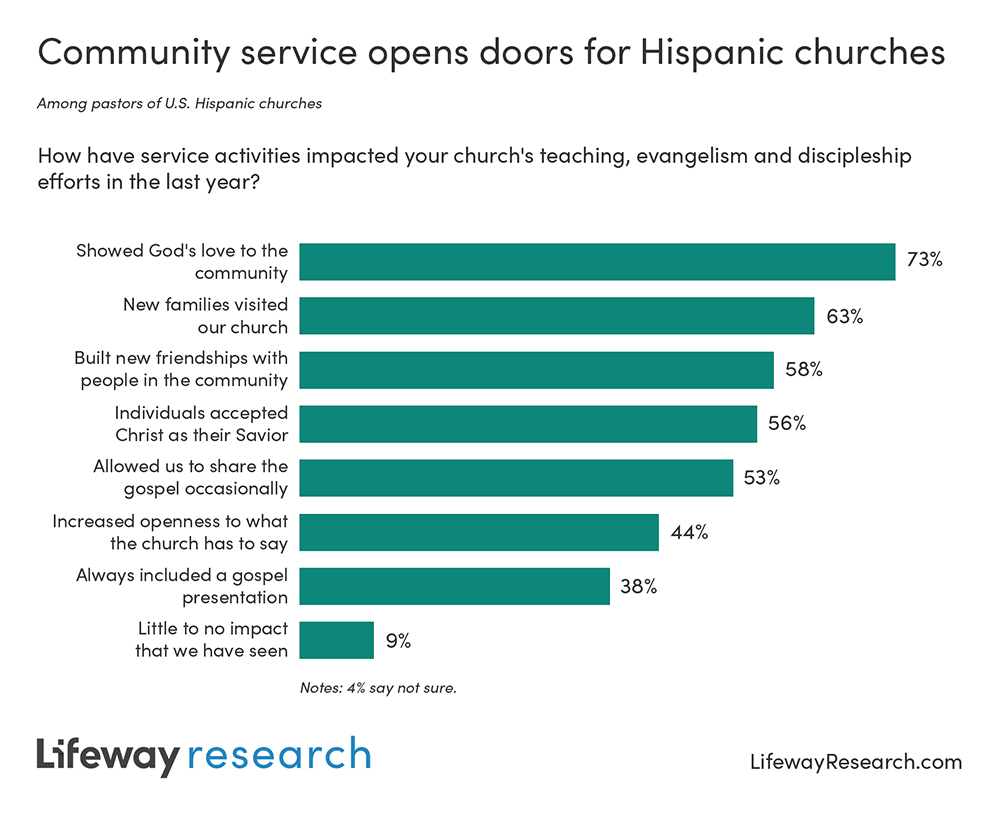
 Sus congregaciones reflejan estilos de servicio de adoración diversos, pero tienen un deseo unificado por alcanzar y servir a sus comunidades.
Sus congregaciones reflejan estilos de servicio de adoración diversos, pero tienen un deseo unificado por alcanzar y servir a sus comunidades.




